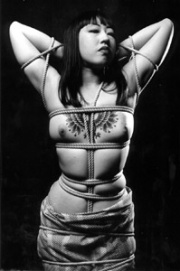Shibari
(restored deleted link) |
(→Development of Shibari) |
||
| Line 6: | Line 6: | ||
==Development of Shibari== | ==Development of Shibari== | ||
| − | According to several sources, | + | According to several sources, Shibari is a development of Hojojutsu techniques dating from Edo period (around 1600). Hojojutsu is a martial art using rope to capture, restrain and even disarm. Hojojutsu often uses ties which are designed to cause discomfort or cause numbness to discourage attempt to escape, e.g. ties which compromise nerves or choke the prisoner. Shibari is a secure and erotic version, which attempts to minimise these risks. It is believed that the erotic woodblock prints of Ito Seiyu, famously depicting his pregnant wife bound, were a significant influence on many notable bondage masters. |
In recent years Japanese style ropework has become popular in the | In recent years Japanese style ropework has become popular in the | ||
western [[BDSM]] scene and 2004 saw the first ever Shibaricon, | western [[BDSM]] scene and 2004 saw the first ever Shibaricon, | ||
| − | an educational conference on Japanese rope bondage | + | an educational conference on Japanese influenced rope bondage |
held in Chicago. | held in Chicago. | ||
Revision as of 18:52, 22 March 2008
Contents |
Bondage

Shibari (literally meaning "bondage") is a Japanese style of sexual bondage or BDSM. Shibari involves tying up the bottom in intricate patterns, usually with several pieces of thin rope. Shibari differs from Western bondage in that, instead of just immobilizing or restraining the bottom, the bottom gains pleasure from being under pressure and strain of the ropes, squeezing the breasts or genitals. The aesthetics of the bound person's position are also important: in particular, Japanese bondage is notorious for its use of asymmetric positions to heighten the psychological impact of bondage.
Although some of the techniques of Japanese sexual bondage originated with the military restraint technique of Hojojutsu, sexual bondage techniques are far gentler, and great care is taken to avoid injury.
Development of Shibari
According to several sources, Shibari is a development of Hojojutsu techniques dating from Edo period (around 1600). Hojojutsu is a martial art using rope to capture, restrain and even disarm. Hojojutsu often uses ties which are designed to cause discomfort or cause numbness to discourage attempt to escape, e.g. ties which compromise nerves or choke the prisoner. Shibari is a secure and erotic version, which attempts to minimise these risks. It is believed that the erotic woodblock prints of Ito Seiyu, famously depicting his pregnant wife bound, were a significant influence on many notable bondage masters.
In recent years Japanese style ropework has become popular in the western BDSM scene and 2004 saw the first ever Shibaricon, an educational conference on Japanese influenced rope bondage held in Chicago.
Glossary
- Japanese Rope Related Terms by Tatu
- RopeMarks' Shibari Glossary
- kinbaku (緊縛): strict bondage
- nawa shibari (縄縛り): rope tying
- nawashi (縄師): This Japanese term is made up of two Japanese terms. "nawa" which means "rope" and "-shi" which means "artist" or practioner of some recognized proficiency (master or teacher). Historically it referred to a maker of rope. It has come to mean "rope artist" in the rope bondage world. The commercial Japanese performance industry will use the term to denote it's professional bondagers.
Topics to be covered
- karada (body harness, a "rope dress", literally "body")
The following two "Japanese bondage's" are specific Western inventions that have -NOT- been picked up by, or originated from, the east.
- sakuranbo ("cherry": crotch rope)
- shinju ("pearl": breast harness)
See also
References
- Midori, Craig Morey, "The Seductive Art of Japanese Bondage", Greenery Press, 2001. ISBN 1890159387
- Master "K", "Shibari, the Art of Japanese Bondage", Secret Publications, 2004. ISBN 9080770620
- RopeMarks Artistic Rope Exchange (R.A.R.E.) - traditional shibari tutorials
- A tutorial on many traditional Japanese Bondage (Shibari / Kinbaku) ties by Tatu
- A brief history of Japanese Rope Bondage and it's influence on all bondage styles by Tatu
External links
- Tutorials on many classic Japanese Bondage (Shibari / Kinbaku) ties by Tatu
- Shibari Fumo Ryu
- Japanese S&M
- Japanese-language site depicting finished Japanese bondage and tying procedures
- RopeMarks - The True Beauty of Bondage
- RopeMarks Artistic Rope Exchange (R.A.R.E.) - online traditional shibari tutorials
- Master "K" at RopeMarks
- Master"K" at Immortal Shibari
- Rope Bondage Peer Workshop
- Shibaricon site
- www.nawashibari.com High quality pay site (with good preview section) focusing on shibari
- The Beginners guide to shibari